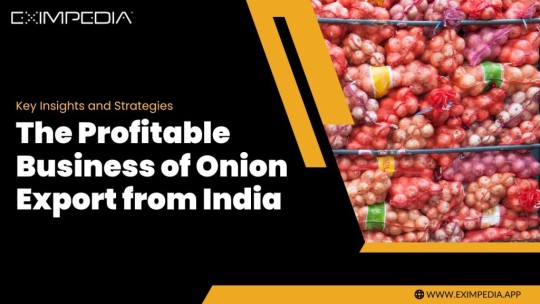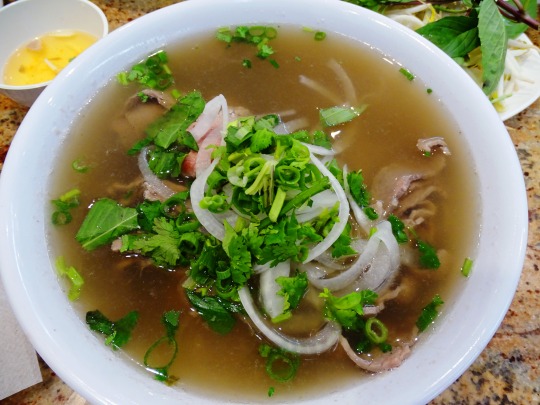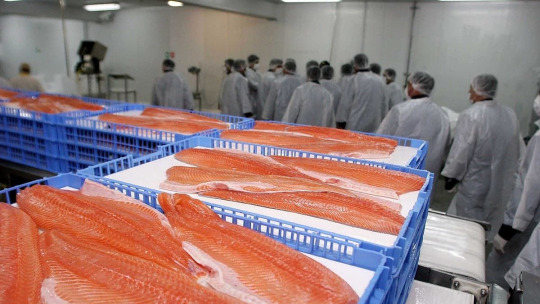#onion export data
Text
0 notes
Text

Dive into the lucrative world of onion export from India with Eximpedia. Discover essential insights and effective strategies to thrive in this profitable business landscape. Unlock the potential of onion exports and stay ahead of the competition with our comprehensive guide.
0 notes
Text
Explore latest onion export data from India market dynamics, production trends and major export destinations. Get information about top onion exporters, market challenges and strategies for success in the global onion trade.
#onion export data from india#onion export data#onion exporter#indian onion exporters#onion exporter in india#onion export from india#onion export
0 notes
Text
Onions are one of the most common vegetables used in cooking dishes; adding a striking taste, colour and smell. Dive into the layered world of onions import export data and its impact on global trade.
#Onions Export Import Data#Onions Buyers Suppliers Details#Onions Importers Exporters Details#Onions Custom Data#Onions Shipment Data
0 notes
Text
Shortly before noon on Aug. 19, 2023, a Russian cruise missile sliced past the golden onion domes and squat apartment blocks of the Chernihiv skyline in northern Ukraine. The Iskander-K missile slammed into its target: the city’s drama theater, which was hosting a meeting of drone manufacturers at the time of the attack. More than 140 people were injured and seven killed. The youngest, 6-year-old Sofia Golynska, had been playing in a nearby park.
Fragments of the missile recovered by the Ukrainian armed forces and analyzed by Ukrainian researchers found numerous components made by U.S. manufacturers in the missile’s onboard navigation system, which enabled it to reach its target with devastating precision. In December, Ukraine’s state anti-corruption agency released an online database of the thousands of foreign-made components recovered from Russian weapons so far.
Russia’s struggle to produce the advanced semiconductors, electrical components, and machine tools needed to fuel its defense industrial base predates the current war and has left it reliant on imports even amid its estrangement from the West. So when Moscow launched its full-scale invasion of Ukraine in February 2022, major manufacturing countries from North America, Europe, and East Asia swiftly imposed export controls on a broad swath of items deemed critical for the Russian arms industry.
Russia quickly became the world’s most sanctioned country: Some 16,000 people and companies were subject to a patchwork of international sanctions and export control orders imposed by a coalition of 39 countries. Export restrictions were painted with such a broad brush that sunglasses, contact lenses, and false teeth were also swept up in the prohibitions. Even items manufactured overseas by foreign companies are prohibited from being sold to Russia if they are made with U.S. tools or software, under a regulation known as the foreign direct product rule.
But as the war reaches its two-year anniversary, export controls have failed to stem the flow of advanced electronics and machinery making their way into Russia as new and convoluted supply chains have been forged through third countries such as Kazakhstan, Turkey, and the United Arab Emirates, which are not party to the export control efforts. An investigation by Nikkei Asia found a tenfold increase in the export of semiconductors from China and Hong Kong to Russia in the immediate aftermath of the war—the majority of them from U.S. manufacturers.
“Life finds a way,” said a senior U.S. intelligence official, quoting the movie Jurassic Park. The official spoke on background to discuss Russia’s evasion of export controls.
Some of the weapons and components analyzed by investigators were likely stockpiled before the war. But widely available Russian trade data reveals a brisk business in imports. More than $1 billion worth of advanced semiconductors from U.S. and European manufacturers made their way into the country last year, according to classified Russian customs service data obtained by Bloomberg. A recent report by the Kyiv School of Economics found that imports of components considered critical for the battlefield had dipped by just 10 percent during the first 10 months of 2023, compared with prewar levels.
This has created a Kafkaesque scenario, the report notes, in which the Ukrainian army is doing battle with Western weapons against a Russian arsenal that also runs on Western components.
It is an obvious problem, well documented by numerous think tank and media reports, but one without an easy solution. Tracking illicit trade in items such as semiconductors is an exponentially greater challenge than monitoring shipments of conventional weapons. Around 1 trillion chips are produced every year. Found in credit cards, toasters, tanks, missile systems, and much, much more, they power the global economy as well as the Russian military. Cutting Russia out of the global supply chain for semiconductors is easier said than done.
“Both Russia and China, and basically all militaries, are using a large number of consumer electronic components in their systems,” said Chris Miller, the author of Chip War: The Fight for the World’s Most Critical Technology. “All of the world’s militaries rely on the same supply chain, which is the supply chain that primarily services consumer electronics.”
Export controls were once neatly tailored to keep specific items, such as nuclear technology, out of the hands of rogue states and terrorist groups. But as Washington vies for technological supremacy with Beijing while also seeking to contain Russia and Iran, it has increasingly used these trade restrictions to advance broader U.S. strategic objectives. For instance, the Biden administration has placed wide-ranging prohibitions on the export of advanced chips to China.
“At no point in history have export controls been more central to our collective security than right now,” Matthew Axelrod, the assistant secretary for export enforcement at the U.S. Commerce Department, said in a speech last September. U.S. National Security Advisor Jake Sullivan has described export controls as “a new strategic asset in the U.S. and allied toolkit.”
Russia’s ability to defy these restrictions doesn’t just have implications for the war in Ukraine. It also raises significant questions about the challenge ahead vis-à-vis China.
“The technological question becomes a key part of this story and whether or not we can restrict it from our adversaries,” said James Byrne, the director of open-source intelligence and analysis at the Royal United Services Institute, a British think tank.
In the Russian city of Izhevsk, home to the factory that manufactures Kalashnikov rifles, shopping malls are being converted into drone factories amid a surge in defense spending that has helped the country’s economy weather its Western estrangement. Arms manufacturers have been urged to work around the clock to feed the Russian war machine, while defense is set to account for one-third of the state budget this year.
“We have developed a concept to convert shopping centers—which, before the start of the SMO [special military operation], sold mainly the products of Western brands—to factories for assembly lines of types of domestic drones,” Alexander Zakharov, the chief designer of the Zala Aero drone company, said at a closed event in August 2022, according to the Russian business newspaper Vedomosti. “Special military operation” is what the Russian government calls its war on Ukraine. Zala Aero is a subsidiary of the Kalashnikov Concern that, along with Zakharov, was sanctioned by the United States last November.
Defense companies have bought at least three shopping malls in Izhevsk to be repurposed for the manufacture of drones, according to local media, including Lancet attack drones, which the British defense ministry described as one of the most effective new weapons that Russia introduced to the battlefield last year. Lancets, which cost about $35,000 to produce, wreaked havoc during Ukraine’s offensive last year and have been captured on video striking valuable Ukrainian tanks and parked MiG fighter jets.
Like a lot of Russia’s weapons systems, Lancets are filled with Western components. An analysis of images of the drones published in December by the Washington-based Institute for Science and International Security found that they contained several parts from U.S., Swiss, and Czech manufacturers, including image processing and analytical components that play a pivotal role in enabling the drones to reach their targets on the battlefield.
“The recurring appearance of these Western products in Russian drone systems shows a keen dependence on them for key capabilities in the drone systems,” the report notes. Lancets are not the only drones found to contain Western components. Almost all of the electronic components in the Iranian Shahed-136 drones, which Russia is now manufacturing with Iranian help to use in Ukraine, are of Western origin, a separate analysis published in November concluded.
Early in the war, the Royal United Services Institute analyzed 27 Russian military systems, including cruise missiles, electronic warfare complexes, and communications systems, and found that they contained at least 450 foreign-made components, revealing Russia’s dependence on imports.
One of the principal ways that Russia has evaded Western export controls has been through transshipment via third countries such as Turkey, the UAE, and neighboring states once part of the Soviet Union. Bloomberg reported last November that amid mounting Western pressure, the UAE had agreed to restrict the export of sensitive goods to Russia and that Turkey was considering a similar move. Kazakh officials announced a ban on the export of certain battlefield goods to Russia in October.
Suspected transshipment is often revealed by striking changes in trade patterns before and after the invasion. The Maldives, an island chain in the Indian Ocean that has no domestic semiconductor industry, shipped almost $54 million worth of U.S.-made semiconductors to Russia in the year after the invasion of Ukraine, Nikkei Asia reported last July.
Semiconductor supply chains often span several countries, with chips designed in one country and manufactured in another before being sold to a series of downstream distributors around the world. That makes it difficult for companies to know the ultimate end user of their products. This may seem odd—until you realize that this is the case for many everyday products that are sold around the world. “When Coca-Cola sells Coca-Cola, it doesn’t know where every bottle goes, and they don’t have systems to track where every bottle goes,” said Kevin Wolf, a former assistant secretary for export administration at the U.S. Commerce Department.
While a coalition of 39 countries, including the world’s major manufacturers of advanced electronics, imposed export restrictions on Russia, much of the rest of the world continues to trade freely with Moscow. Components manufactured in coalition countries will often begin their journey to Moscow’s weapons factories through a series of entirely legal transactions before ending up with a final distributor that takes them across the border into Russia. “It starts off as licit trade and ends up as illicit trade,” said a second senior U.S. intelligence official, who spoke on condition of anonymity.
The further items move down the supply chain, the less insight governments and companies have into their ultimate destination, although sudden changes in behavior of importers can offer a red flag. In his speech last September, Axelrod, the assistant secretary, used the example of a beauty salon that suddenly starts to import electronic components.
But the Grand Canyon of loopholes is China, which has stood by Moscow since the invasion. In the first days of the war, U.S. Commerce Secretary Gina Raimondo warned that Washington could shut down Chinese companies that ignored semiconductor export controls placed on Russia. Last October, 42 Chinese companies were added to export control lists—severely undercutting their ability to do business with U.S. companies—for supplying Russian defense manufacturers with U.S. chips.
But as the Biden administration carefully calibrates its China policy in a bid to keep a lid on escalating tensions, it has held off from taking Beijing to task. “I think the biggest issue is that we—the West—have been unwilling to put pressure on China that would get China to start enforcing some of these rules itself,” said Miller, the author of Chip Wars.
A spokesperson for the U.S. Commerce Department’s Bureau of Industry and Security (BIS) said: “Due to the restrictions imposed by the United States and key allies and partners, Russia has been left with no choice but to spend more, lower its ambitions for high-tech weaponry, build alliances with other international pariah states, and develop nefarious trade networks to covertly obtain the technologies it needs.
“We are deeply concerned regarding [Chinese] support for Russia’s defense industrial base. BIS has acted to add over 100 [China]-based entities to the Entity List for supporting Russia’s military industrial base and related activities.”
Export controls have typically focused on keeping specific U.S.-made goods out of the hands of adversaries, while economic and financial sanctions have served broader foreign-policy objectives of isolating rogue states and cauterizing the financing of terrorist groups and drug cartels. The use of sanctions as a national security tool grew in wake of the 9/11 attacks; in the intervening decades, companies, government agencies, and financial institutions have built up a wealth of experience in sanctions compliance. By contrast, the use of export controls for strategic ends is relatively novel, and compliance expertise is still in its infancy.
“It used to be that people like me could keep export controls and sanctions in one person’s head. The level of complexity for each area of law is so intense. I don’t know anyone who is truly an export control and sanctions expert,” Wolf said.
Export controls, experts say, are at best speed bumps designed to make it harder for Russia’s defense industrial base to procure Western components. They create “extra friction and pressure on the Russian economy,” said Daniel Fried, who as the State Department coordinator for sanctions policy helped craft U.S. sanctions on Russia after its annexation of Crimea in 2014. Russia is now paying 80 percent more to import semiconductors than it did before the war, according to forthcoming research by Miller, and the components it is able to acquire are often of dubious quality.
But although it may be more cumbersome and expensive, it’s a cost that Moscow has been willing to bear in its war on Ukraine.
Western components—and lots of them—will continue to be found in the weapons Russia uses on Ukraine’s battlefields for the duration of the war. “This problem is as old as export controls are,” said Jasper Helder, an expert on export controls and sanctions with the law firm Akin Gump. But there are ways to further plug the gaps.
Steeper penalties could incentivize U.S. companies to take a more proactive role in ensuring their products don’t wind up in the hands of the Russian military, said Elina Ribakova, a nonresident senior fellow at the Peterson Institute for International Economics. “At the moment, they’re not truly motivated,” she said.
Companies that run afoul of sanctions and the Foreign Corrupt Practices Act, a U.S. federal law that prohibits the payment of bribes, have been fined billions of dollars. Settlements of export control violations are often an order of magnitude smaller, according to recently published research.
In a speech last month, Axelrod said the United States would begin issuing steeper penalties for export control violations. “Build one case against one of the companies extremely well, put out a multibillion-dollar fine negotiation, and watch everybody else fall in line,” Ribakova said.
And then there’s the question of resources. BIS has an annual budget of just $200 million. “That’s like the cost of a few fighter jets. Come on,” said Raimondo, speaking at the Reagan National Defense Forum last December.
The agency’s core budget for export control has, adjusted for inflation, remained flat since 2010, while its workload has surged. Between 2014 and 2022, the volume of U.S. exports subject to licensing scrutiny increased by 126 percent, according to an agency spokesperson. A 2022 study of export control enforcement by the Center for Strategic and International Studies recommended a budget increase of $45 million annually, describing it as “one of the best opportunities available anywhere in U.S. national security.”
When it comes to enforcement, the bureau has about 150 officers across the country who work with law enforcement and conduct outreach to companies. The Commerce Department has also established a task force with the Justice Department to keep advanced technologies out of the hands of Russia, China, and Iran. “The U.S. has the most robust export enforcement on the planet,” Wolf said.
But compared with other law enforcement and national security agencies, the bureau’s budgets have not kept pace with its expanding mission. The Department of Homeland Security has more investigators in the city of Tampa, Florida, than BIS does across the entire country, Axelrod noted in his January speech.
On the other side, you have Russia, which is extremely motivated to acquire the critical technologies it needs to continue to prosecute its war. The Kremlin has tasked its intelligence agencies with finding ways around sanctions and export controls, U.S. Treasury Undersecretary Brian Nelson said in a speech last year. “We are not talking about a profit-seeking firm looking for efficiencies,” the second senior U.S. intelligence official said. “There will be supply if there is sufficient demand.”
18 notes
·
View notes
Text

















National Onion Day
Today, farmers in the United States are collecting millions of onions. They will be heading for store shelves to provide families with the fresh, nutritional, tasty power to improve meals and boost the body’s immunity. Onions have numerous advantages, such as enhancing meals with a variety of flavors. According to recent research, consuming onions also helps the body fight colorectal cancer and breast cancer, as well as heart disease and diabetes.
National Onion Day commemorates the incorporation of the National Onion Association in 1913. The organization was created to protect the interests of America’s onion growers, and onions remain their business to this day. Today, the group represents over 500 onion producers, shippers, packers, and suppliers across the country.
History of National Onion Day
In June 2022, the National Onion Association established National Onion Day to commemorate the organization’s 53rd anniversary. They officially incorporated on June 27, 1913, in Ohio, and represent almost 500 onion farmers, shippers, packers, and allied members across the U.S.
Onions are one of the world’s oldest cultivated vegetables, having originated in Central Asia and spread around the world. Some researchers believe the onion has been cultivated for at least 5,000 years. Onions were possibly eaten for thousands of years and cultivated all over the world at the same time, since they grew wild in different locations.
We rely on the onion to improve the flavor of our savory meals, whether we use a sweet, white, red, or ever-popular yellow onion. They complement meats and salads, making the versatile onion a culinary powerhouse. It’s the needed seasoning alongside our salt and pepper, whether added to eggs or pickled. While the onion is low in calories, it is also high in vitamin C and antioxidants, and can increase your dietary fiber and vitamin B6 intake. Unlike many other low-calorie ingredients, onions provide a high nutritional content without compromising flavor. And it makes no difference what you do to it; pickled or raw, caramelized, sauteed, or pureed — the onion adds a lot of flavor to a dish. With so many types to choose from, onions present numerous opportunities to reap the benefits.
National Onion Day timeline
3500 B.C. The Onion is First Traced in Egypt
The history of the onion can be traced back to this period, with a Sumerian document describing someone being in awe of the city governor’s onion garden.
1500 B.C. Ancient Egypt Worships Onions
To those who bury onions alongside their pharaohs, onions are a sign of eternity.
1913 National Onion Association Is Founded
On June 2, the National Onion Association is formally incorporated in Ohio.
2019 National Onion Day is First Celebrated
The National Onion Association establishes National Onion Day on June 27, to honor onion producers.
National Onion Day FAQs
Is an onion a vegetable or a fruit?
The vegetables are classified based on the edible part of the plant: leaves (like lettuce), roots (like carrot), bulbs (such as onions), and many others. Alternatively, fruits such as tomatoes and seeds such as peas are commonly referred to as vegetables.
Which country is the largest onion exporter?
According to FY18 data, China appears to be the top onion producer, but the Netherlands is the largest onion exporter.
Do onions aid in the treatment of infections?
Onions were worshiped for their medicinal powers by various civilizations. They have anti-inflammatory properties, relieve joint pain, treat ear infections, work as an antibiotic, and are an excellent expectorant for loosening up thick phlegm.
National Onion Day Activities
Add fresh onion to your favorite recipe
Learn how to grow onions in your backyard
Share the celebration on social media
For a flavor boost, be sure to add some onion in there. No matter how you slice it, onion pulls together some of the greatest flavors! Tell us how you like to cook your onions!
Gardening is fun! Furthermore, if you can cultivate some veggies like onions in your backyard, you can reduce the cost of your monthly groceries by harvesting them yourself.
Be sure to spread the word about National Onion Day by using the hashtag #NationalOnionDay on social media. Also, don’t forget to brag about your onion recipe or how you harvested your own onions.
5 Interesting Facts About Onion
They’ve been around for thousands of years
Sulfuric acid
Onions were worshiped by Ancient Egyptians
The biggest onion ever
The Big Onion
Onions have been present for thousands of years and, around 3,500 B.C, onions were harvested for the first time.
The reason you become teary-eyed when cutting onions is because of the sulfuric acid they contain.
They claimed that the spherical shape and concentric circles represented eternity — onions were used to cover the tombs of their monarchs and were important in ritual burials.
According to ‘The Guinness Book of World Records’, the biggest onion ever was cultivated by Peter Glazebrook, a British farmer, who grew a massive onion in 2011 that weighed just under 18 pounds.
Before it was known as the Big Apple, New York was known as the Big Onion, because it was a place where you could peel layer after layer without touching the center, kind of like an onion.
Why We Love National Onion Day
It encourages cultivation
It promotes culinary creativity
It boosts the immune system
Onions are an important, and healthy part of our diet. Why not grow and cultivate your own in your backyard?
Who would have thought onions, known for making us cry, could be so sweet and delectable with some creativity? These days, almost all culinary innovations use onion for a unique flavor.
Onions are rich in prebiotics. This helps to increase friendly bacteria in your guy, which helps to build immunity against viruses.
Source
#vacation#Jaime-Style with cheese & sauce Burrito#USA#food#Chow Line#Cowboy Burger#Chili Burger#Texas Roadhouse Chili#steak with mushrooms#Onion Rings#Pho Tai#Beef Black Pepper#Crispy Rice Noodle Tower#Pavla Plate#Green Chile Burger#National Onion Day#27 food#travel#original photography#restaurant#Canada#Fire Jumper Burger#Roast beef with remoulade & fried onions Smörrebröd#Greek Pizza
12 notes
·
View notes
Text
Chile targets Brazil to promote and expand exports

Chile is renewing its strategy to increase and diversify exports to the largest economy and market in South America. Spearheaded by ProChile, an arm of the country’s Ministry of Foreign Affairs, the plan is to expand its network in Brazil with new offices in Brasília and Belo Horizonte.
The strategy includes strengthening digital avenues to increase trade and market events to promote an export basket that ranges from olive oil to pork, onion, garlic and the classic wines item.
However the goal of diversifying exports will not make ProChile lose track of the country’s flagship in Brazil. Salmon and trout sales, which currently lead the list, generated US$ 673 million between January and October, up 12.4% from the same period last year.
In terms of agribusiness exports, Brazil is Chile’s third-largest export destination. The US leads with US$ 5.4 billion in the first ten months of this year, representing a growth of 29.9%, according to data from ProChile.
Continue reading.
#brazil#politics#chile#chilean politics#brazilian politics#economy#international politics#mod nise da silveira#image description in alt
3 notes
·
View notes
Text
Understanding the Dynamics of Vegetable Export from India

India, a country renowned for its agricultural prowess, has been making significant strides in the vegetable export sector. With its diverse climate and fertile soil, India produces a wide range of vegetables that are in high demand across the globe. The vegetable export industry not only boosts the nation's economy but also supports the livelihoods of millions of farmers. In this article, we'll delve into the various facets of vegetable export from India, including key data, major players, top exported vegetables, and the process of exporting vegetables from India.
The Growth of Vegetable Export from India
The vegetable export from India has seen a remarkable increase over the past few decades. According to the Agricultural and Processed Food Products Export Development Authority (APEDA), India exported vegetables worth approximately USD 1.62 billion in the financial year 2022-23. This figure underscores the significant role that vegetable export plays in India's overall agricultural export portfolio. The rising demand for Indian vegetables in international markets is driven by their quality, diversity, and competitive pricing.
Analyzing Vegetable Export Data
Examining vegetable export data provides valuable insights into trends and growth patterns. For instance, in 2022-23, the export volume of vegetables from India stood at around 2.6 million metric tons. This data indicates a steady increase in both the volume and value of vegetable exports over the years. The top destinations for Indian vegetables include the United Arab Emirates, Bangladesh, Malaysia, Sri Lanka, and the United Kingdom. These countries appreciate the freshness and quality of Indian produce, making them major importers.
Major Players in the Vegetable Export Industry
When it comes to the top vegetable exporters in India, several companies have established themselves as leaders in the industry. Organizations like Mother Dairy, Mahindra Agri Solutions, and ITC Limited have made significant contributions to the vegetable export market. These companies have developed robust supply chains, ensuring that vegetables reach international markets in the best possible condition. Additionally, numerous small and medium enterprises (SMEs) are also making their mark by exporting niche and organic vegetables, thus contributing to the sector's growth.
Top 10 Vegetables Exported from India
India's vast agricultural landscape allows it to produce a variety of vegetables that are popular in global markets. Here are the top 10 vegetables exported from India:
Onions: India is one of the largest exporters of onions, known for their pungency and flavor. Indian onions are particularly popular in Southeast Asia and the Middle East.
Potatoes: Indian potatoes are in demand due to their versatility and quality, finding markets in countries like Nepal, Sri Lanka, and the UAE.
Tomatoes: Both fresh and processed tomatoes from India are sought after in the Middle East and European countries.
Okra (Lady Finger): Okra is a staple in many African and Middle Eastern cuisines, making it a significant export item.
Cabbage: Indian cabbage is appreciated for its quality and is exported mainly to Asian countries.
Carrots: With high demand for fresh and processed carrots, India exports them to various countries, including Malaysia and Bangladesh.
Green Peas: Frozen green peas from India are popular in Western markets due to their quality and availability.
Eggplants (Brinjal): Indian eggplants are favored for their taste and are exported to Asian and European markets.
Bitter Gourd: Known for its health benefits, bitter gourd has a niche market, particularly in Asian countries.
Spinach: Both fresh and frozen spinach from India cater to health-conscious consumers worldwide.
Steps to Export Vegetables from India
For those looking to enter the vegetable export business, understanding the process is crucial. Here’s a step-by-step guide on how to export vegetables from India:
Obtain Required Licenses and Registrations: The first step is to get an Importer Exporter Code (IEC) from the Directorate General of Foreign Trade (DGFT). Additionally, registering with APEDA is essential for certification and other support.
Ensure Quality Control: Maintaining high quality is vital. This involves proper farming practices, hygienic packaging, and adherence to international standards such as HACCP and ISO.
Market Research: Conduct thorough research to identify potential markets. Analyze the demand, competition, and pricing strategies in different countries.
Develop a Supply Chain: Establish a robust supply chain to ensure that vegetables remain fresh from the farm to the international markets. This includes efficient logistics, cold storage facilities, and reliable transportation.
Build Networks: Establish connections with international buyers, distributors, and wholesalers. Participating in trade fairs and exhibitions can help in building these networks.
Compliance with Regulations: Ensure compliance with the export regulations of both India and the importing country. This includes proper documentation like the shipping bill, certificate of origin, and phytosanitary certificate.
Financial Management: Arrange for secure payment methods and be aware of foreign exchange regulations to mitigate financial risks.
Challenges in the Vegetable Export Sector
Despite its growth, the vegetable export industry in India faces several challenges. Perishability is a major concern, requiring efficient cold chain logistics. Quality control is another critical issue, as international markets have stringent standards. Additionally, competition from other vegetable-exporting countries and fluctuating global prices add to the complexities. Addressing these challenges requires investment in infrastructure, adoption of advanced technologies, and continuous market research.
Conclusion
Vegetable export from India is a vibrant and expanding industry with immense potential. The country's diverse agricultural resources, coupled with increasing global demand, position India as a significant player in the international vegetable market. By focusing on quality, efficient supply chain management, and understanding market dynamics, Indian exporters can continue to thrive. The vegetable export sector not only contributes to the economy but also showcases India's agricultural expertise on a global platform.
#Vegetable export from India#Vegetable export data#Vegetable export#Top vegetable exporters in India#Top 10 vegetables exported from india#How to export vegetables from India
0 notes
Text
India's Flourishing Vegetables Export Industry: A Detailed Insight

India, with its vast agricultural resources and diverse climate, has established itself as a significant player in the global vegetables market. The country's vegetables export from India has seen remarkable growth, contributing to the economy and meeting international demand for fresh and dehydrated vegetables. This article delves into the nuances of vegetables export from India, examining key data, leading exporters, and major importing countries.
The Significance of Vegetables Export from India
India's agriculture sector plays a crucial role in the economy, with vegetables forming a substantial part of the export portfolio. The country's rich soil and varied climatic conditions allow for the cultivation of a wide range of vegetables, which are exported to numerous countries worldwide.
Overview of Vegetables Export Data
Vegetables export data indicates a robust and growing industry. In recent years, India has exported millions of tonnes of vegetables, generating substantial revenue. The vegetables hs code, which is the harmonized system code used to classify goods in international trade, for fresh and dehydrated vegetables falls under chapters 07 and 20 respectively, helping streamline and categorize the export process.
List of Vegetables Exported from India
India exports a diverse range of vegetables, both fresh and dehydrated. The list of vegetables exported from India includes:
Onions
Potatoes
Tomatoes
Green chilies
Okra
Eggplants
Carrots
Spinach
Cabbages
Cauliflowers
Most Exported Vegetables from India
Among these, the most exported vegetables from India are onions, potatoes, and tomatoes. These vegetables are in high demand due to their versatility, nutritional value, and extensive use in various cuisines around the world.
Export of Dehydrated Vegetables from India
In addition to fresh vegetables, the export of dehydrated vegetables from India has also gained momentum. Dehydrated vegetables, such as dried onions, garlic, and green beans, offer longer shelf life and ease of transport, making them a preferred choice for many international markets. Dehydrated vegetables exporters in India have capitalized on this demand, ensuring high-quality products through advanced processing techniques.
Vegetables Exporters in India
India boasts numerous reputable vegetables exporters who have established a strong presence in the global market. These exporters ensure that Indian vegetables meet international quality standards and are delivered fresh. Some of the leading names include:
Allanasons Pvt Ltd
Tirupati Balaji Agro Products Pvt Ltd
Atmiya International
S K Fresh Produce
K M Exports
Major Vegetable Importing Countries
The list of vegetable importing countries from India includes several major economies and emerging markets. The primary vegetable importing countries from India are:
United Arab Emirates
Saudi Arabia
Bangladesh
Malaysia
Sri Lanka
United Kingdom
Netherlands
Nepal
Qatar
Germany
These countries import significant quantities of Indian vegetables due to their high quality, competitive pricing, and the reliability of Indian exporters.
India's Position Among Top Vegetable Exporting Countries
India is consistently ranked among the top 10 vegetable exporting countries in the world. The country's strategic advantage lies in its ability to produce a wide variety of vegetables throughout the year, ensuring a steady supply to international markets.
Challenges Faced by Vegetable Exporters in India
Despite the success, vegetables exporters in India face several challenges, including:
Quality Control: Maintaining consistent quality to meet international standards.
Logistics: Ensuring efficient cold chain logistics to preserve the freshness of vegetables.
Regulatory Compliance: Navigating various international trade regulations and phytosanitary standards.
Climate Variability: Dealing with the impact of climate change on crop yields.
Government Support and Initiatives
The Indian government has implemented several initiatives to support vegetables export from India. Schemes such as the Agricultural and Processed Food Products Export Development Authority (APEDA) provide financial assistance, quality control support, and market access initiatives to boost exports.
Sustainability and Organic Farming
Sustainability is becoming a focal point in the agriculture sector. Many Indian farmers and exporters are adopting organic farming practices to meet the growing global demand for organic produce. This shift not only enhances the marketability of Indian vegetables but also promotes environmental conservation and soil health.
Technological Advancements in Vegetable Farming
Technological advancements are playing a pivotal role in enhancing the efficiency and productivity of vegetable farming in India. Innovations such as precision farming, drip irrigation, and controlled environment agriculture are helping farmers increase yields and improve quality.
Future Prospects of Vegetables Export from India
The future of vegetables export from India looks promising, with increasing global demand for fresh and high-quality produce. Expanding market access, improving logistics infrastructure, and adopting sustainable farming practices are expected to drive growth in this sector. Additionally, the rise of e-commerce platforms is opening new avenues for direct-to-consumer sales, further boosting exports.
Conclusion
The vegetables export industry in India is a dynamic and vital component of the agricultural sector. With a diverse range of high-quality vegetables, reliable exporters, and strong government support, India continues to strengthen its position in the global market. As the industry navigates challenges and embraces innovation, the future of vegetables export from India looks bright and full of potential.
#vegetables export from india#vegetables export data#vegetables hs code#india vegetable export#vegetables exporters in india#vegetables importers#vegetable importing countries#top 10 vegetable exporting countries#list of vegetables exported from india#export of dehydrated vegetables from india#vegetable importing countries from india#dehydrated vegetables exporters india#most exported vegetables from india
0 notes
Text
TOP NEWS Agricultural Commodities > EXCLUSIVE-Russia's dispute with leading exporter blocks 400,000 metric tons of > Large areas of EU winter grain in mediocre condition, monitor says > Brazil's 2023/24 soybean harvest hits 69%, says AgRural > GRAINS-Wheat near 3-week high amid concerns over Russian shipments > South Korean mills buy 30,200 metric tons of wheat from US, traders say > SOFTS-Cocoa soars to record highs; sugar and coffee also up > VEGOILS-Palm oil climbs on strong export data, weak output growth > US detects avian flu in milk, says dairy supplies are safe > Egypt's GASC extends deadline of sugar tender, adds arrival periods > Ivory coast rains sufficient to sustain cocoa mid-crop, farmers say > British farmers protest outside parliament over food imports > India extends ban on onion exports indefinitely ahead of general election > COLUMN-Funds chip away at CBOT grain, oilseed shorts ahead of key US data -Braun
0 notes
Text
0 notes
Text
https://www.seair.co.in/blog/onion-export-data-from-india-major-list-of-onion-exporters.aspx

Unlock valuable insights into onion export data from India with Seair Exim Solutions' latest blog. Explore a comprehensive list of major onion exporters and gain crucial market intelligence for your trade endeavors.
#onion export data from india#onion export data#onion exporter#indian onion exporters#onion exporter in india#onion export from india#onion export
0 notes
Text
Exploring the Onion Export Data from India and Major Exporters with Seair Exim Solutions' comprehensive analysis. Delve into the onion export data, top exporters, and trends shaping the global market.
#onion export data from india#onion export data#onion exporter#indian onion exporters#onion exporter in india#onion export from india#onion export
0 notes
Text
India import export data | Global Import export data provider
Exim Trade Data experts are continuously working in the import-export sector just to update the data on a weekly basis. Our database contains more than 200+ countries' import-export data with visual graphs so that the clients who are using our database can understand it easily. India to begin onion exports to Bahrain, Bhutan and Mauritius. You also can check out the sample of India Import Export Data by clicking the below link -https://eximtradedata.com/india-import-export-data
More information about India's plastics exports up 5% during January : https://globalimportexportdataprovider.blogspot.com/2024/03/indias-plastics-exports-up-5-during.html

#indiaimportexportdata#indiacustomsdata#globalimportexportdata#Indiaimportdata#indiashipmentdata#indiatradedata#indiaexportdata#importexportdata#globalimportexportdataprovider
0 notes
Text
The top exporters of onions were China, Netherlands, Spain, Mexico and India and the top importers of onions were United States, Indonesia, Vietnam, Germany and Brazil. Download Onions buyers suppliers details here.
0 notes